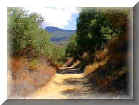(an article by Catherine)

A wild garden isn't a garden gone wild but one
composed of indigenous plants. It has two distinct advantages; no watering and no
weeds. By definition a weed is a plant one doesn't want growing where it is.
In the native garden everything belongs. The only weed would be the occasional
non-native that needs to be removed. In Southern California, these are mostly
Mediterranean grasses brought in the intestines of the first Spanish cattle and migrants
from neighbors' yards who insist on planting Eucalyptus and Locust
If you will notice in wild areas with the
exception of the desert and the beach, there is no bare dirt. Every square
inch of ground is covered with plant material. Even the rocks grow moss and lichen with the
occasional pioneer tree sprouting from a crack. The thing that allows for this
phenomenon is species diversity. In what we call a monoculture, the typical garden
where rows of like plants are neatly spaced, there is competition for nutrients, light,
water and air. Gardeners adjust for this by watering, spacing plants with weed free bare
dirt between them and by fertilizing. In the wild the plants have adjusted
themselves by having lots of different species with different requirements of light and
shade, nutrients and moisture, upper story, understory and ground cover until the place is
thick and rich with plant life. Each group of plants that have adjusted themselves
to live together like that are known as a biome.
and lichen with the
occasional pioneer tree sprouting from a crack. The thing that allows for this
phenomenon is species diversity. In what we call a monoculture, the typical garden
where rows of like plants are neatly spaced, there is competition for nutrients, light,
water and air. Gardeners adjust for this by watering, spacing plants with weed free bare
dirt between them and by fertilizing. In the wild the plants have adjusted
themselves by having lots of different species with different requirements of light and
shade, nutrients and moisture, upper story, understory and ground cover until the place is
thick and rich with plant life. Each group of plants that have adjusted themselves
to live together like that are known as a biome.

And that's not all. You have to have
animals that go with it. The ants and gophers, worms and other subsoil critters
till; turning up nutrients for the plants. Insects carry pollen from plant to plant
and birds are the natural insecticide. Small predators; coyote, kit fox, bob cat and
red tail hawk control the rodent population. When the wild gardener gets involved
they have to be very careful not to upset that balance. The gardener's pet pussy
seems innocent enough but it makes great changes. By eating a lizard the ant
population has a chance to explode. By eating a bird the insect population is
increased. Thus pussy has removed two natural insecticides. When the coyote
eats puss and starts coming around humans looking for another such easily caught, tasty
treat, the balance is thrown off further as the coyote's natural prey population
increases. One may think of these introduced pets as a sort of faunal weed species.
In conclusion, when you think wild, think
diversity and balance. Try to figure out what each plant is doing in its environment
and what it needs.

